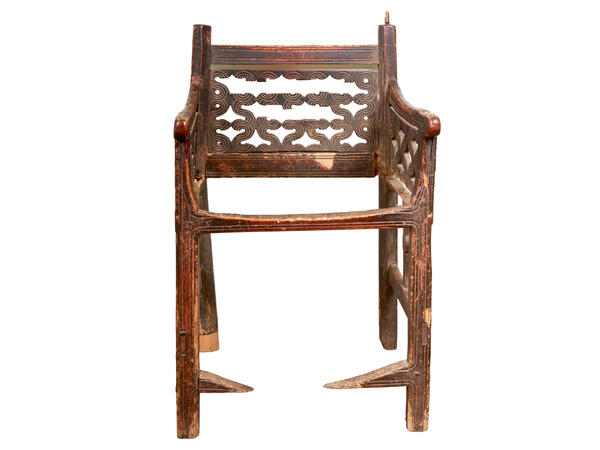The exhibition of the museum-reserve displays a wooden armchair that belonged to the last Kasimov queen Fatima-Sultan Seitovna.
The chair was made in the 17th century. It had a carcass of quadrangular columns with round balls at the ends. The high back, as well as the sides of the armrests, were carved, with an undulating ornament. The craftsman applied the patterns in two different ways: deep cutting and small slits. That way, the stripes of the ornament were of different shades.
Fatima Sultan Seitovna was the 14th ruler of the Kasimov khanate and the only woman in 229 years who was at the head of the kingdom. She belonged to a famous Tatar family, which, according to legend, descended from the Prophet Muhammad.
In 1614, Fatima’s husband, Sultan Arslan, received a letter of grant from Moscow and became Kasimov Khan. After his death, his son Seyid-Burhan inherited the throne, at that time he was only two years old. Fatima Sultan became regent under her son and began to rule the region. After she died in 1681, the Kasimov khanate was abolished.
Fatima Sultan Seitovna favored Orthodoxy and helped the Kasimov Kazan Convent, which was founded in the first half of the 17th century. She donated several icons and even embroidered an icon plating with silver threads for one of them with her own hands.
There were several legends about Fatima-Sultan Seitovna in Kasimov. One of them said that the tsarina liked to travel around the city in an ornate golden carriage drawn not by horses, but by “dirty serving people.” One day, her servants allegedly rebelled and refused to take Fatima Sultan around the city. The tsarina got angry, started shouting and calling the rebels “alyans” — translated from Tatar it meant “lazy” or “stubborn”.
According to the legend, from “alyan” a family of merchants Alyanchikov originated, who were entrepreneurs and got rich on wine farming. They bought the right to trade alcohol from the state. The family owned several drinking establishments in Kasimov. Now the Kasimov Historical and Cultural Museum-Reserve is located in the Alyanchikov’s house on Cathedral Square.
The chair was made in the 17th century. It had a carcass of quadrangular columns with round balls at the ends. The high back, as well as the sides of the armrests, were carved, with an undulating ornament. The craftsman applied the patterns in two different ways: deep cutting and small slits. That way, the stripes of the ornament were of different shades.
Fatima Sultan Seitovna was the 14th ruler of the Kasimov khanate and the only woman in 229 years who was at the head of the kingdom. She belonged to a famous Tatar family, which, according to legend, descended from the Prophet Muhammad.
In 1614, Fatima’s husband, Sultan Arslan, received a letter of grant from Moscow and became Kasimov Khan. After his death, his son Seyid-Burhan inherited the throne, at that time he was only two years old. Fatima Sultan became regent under her son and began to rule the region. After she died in 1681, the Kasimov khanate was abolished.
Fatima Sultan Seitovna favored Orthodoxy and helped the Kasimov Kazan Convent, which was founded in the first half of the 17th century. She donated several icons and even embroidered an icon plating with silver threads for one of them with her own hands.
There were several legends about Fatima-Sultan Seitovna in Kasimov. One of them said that the tsarina liked to travel around the city in an ornate golden carriage drawn not by horses, but by “dirty serving people.” One day, her servants allegedly rebelled and refused to take Fatima Sultan around the city. The tsarina got angry, started shouting and calling the rebels “alyans” — translated from Tatar it meant “lazy” or “stubborn”.
According to the legend, from “alyan” a family of merchants Alyanchikov originated, who were entrepreneurs and got rich on wine farming. They bought the right to trade alcohol from the state. The family owned several drinking establishments in Kasimov. Now the Kasimov Historical and Cultural Museum-Reserve is located in the Alyanchikov’s house on Cathedral Square.


